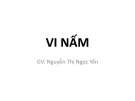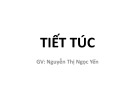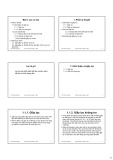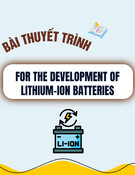PHƯƠNG PHÁP SOLGEL TiO2-CdS
Nguyễn ĐằngTrai
I. TẠO SOL TiO2/CdS
CdS: II-VI TiO2: 3.21 eV to 3.4 eV CdS : 2.42 eV Các hóa chất cần thiết:
◦ Titanium (IV) isopropoxide. ◦ Cadmium acetate hydrate. ◦ Ethanol. ◦ H2S. ◦ HCl.
Ti[OCH(CH3)2]4 Colorless liquid M = 284 g/mol d = 0.937 g/cm3 Melting, boiling: 18–20 C, 232 C
Titanium (IV) isopropoxide
(CH3CO2)2Cd . xH2O (CH3CO2)2Cd . 2H2O ◦ White crystals ◦ M = 266.529 g/mol ◦ d = 2.01 g/cm3 ◦ Melting point: 130 C ◦ Soluble in water, ethanol.
Cadmium acetate hydrate
C2H5OH Colourless liquid M = 46.07 g/mol d = 0.789 g/cm3 Melting, boiling: −114 C, 78 C
Ethanol
◦ 0.4 g/100 ml (20 C) ◦ 0.25 g/100 ml (40 C)
Điều chế H2S:
◦ Không điều chế trong công nghiệp. ◦ HI+SO2H2O+H2S+I2 ◦ Trong phòng thí nghiệm:
Hydro sulfua H2S (ít tan trong nước) Colorless gas. M = 34.082 g/mol d = 1.363 g/l Melting, boiling: -82.30 C, -60.28 C Solubility in water:
FeS + 2HCl FeCl2 + H2S
Titanium (IV) isopropoxide Ethanol (5ml : 25ml)
Ethanol Cadmium acetate (25ml : 0.5g)
Stir in an ice bath
Mix in ice bath
one drop of 0.5M HCl
Colorless Transparent
Until:
Add slowly
Yellow white Semi-transparent
saturated H2S water solution
SOL TiO2/CdS
II.TẠO SOL CdS
Colour: yellow to orange d = 4830 kg m-3
1. Cách 1:
Các hóa chất cần thiết:
◦ Polyethylene glycol (PEG) ◦ Cadmium nitrate (cung cấp Cd) ◦ Thiourea (cung cấp S) ◦ Ethanol ◦ Acetic Acid
H(OCH2CH2)nOH
Polyethylene glycol
Cd(NO3)2 White crystals M = 236 g/mol d = 3.60 g/cm3 Mp: 350 C
Cadmium nitrate
SC(NH2)2 White solid M = 76 g/mol d = 1.405 g/ml Mp: 182 C
Thiourea
C2H5OH Colourless liquid M = 46.07 g/mol d = 0.789 g/cm3 Melting, boiling: −114 C, 78 C
Ethanol
Acetic acid
CH3COOH Colourless liquid M = 60 g/mol d = 1.049 g/cm3 Mp, Bp: 16.5 C, 118.1 C
Polyethylene glycol Ethanol (0.6 ml 8.9 ml)
Cadmium nitrate (0.3 mol/l) Thiourea (0.3, 0.4 , 0.6 mol/l) Ethanol
Stir
Stir (1-hour)
Acetic Acid (0.5 ml)
Continue stir (1-hour)
Add slowly
Stir (5-6 hours)
SOL
2. Cách 2:
Các hóa chất cần thiết:
◦ Cadmium acetate dihydrate (CAD) ◦ Thiourea (Tu) ◦ 1-Thioglycerol (TG) ◦ N,N-dimethylformamide (DMF)
(CH3CO2)2Cd . 2H2O ◦ White crystals ◦ M = 266.529 g/mol ◦ d = 2.01 g/cm3 ◦ Melting point: 130 C ◦ Soluble in water, ethanol.
Cadmium acetate hydrate
1-thioglycerol HSCH2CH(OH)CH2OH M = 108 g/mol d = 1.25 g/mL at 25 C
SC(NH2)2 White solid M = 76 g/mol d = 1.405 g/ml Mp: 182 C
Thiourea
(CH3)2NC(O)H Clear liquid M = 73 g/mol d = 0.944 g/cm3 Mp, Bp: -61 C, 153 C
N,N-dimethylformamide
CAD
20 mL
Tu
DMF Water (3:1 vol)
TG
CdS sol
3. Cách 3:
Các hóa chất cần thiết:
◦ Cadmium nitride ◦ Ammonium thiocyanate ◦ n-Buthanol
Cd3N2 Black powder M = 365 g/mol
3Cd(NH2)2(s) (180 C) → Cd3N2(s) +
4NH3(g)
Cadmium nitride
NH4SCN Crystalline solid M = 76 g/mol d = 1.305 g/cm3 Mp, Bp: 149.5 C, 170 C
Ammonium thiocyanate
C4H10O Colourless liquid M = 74 g/mol d = 0.8098 g/cm3 Mp, Bp: −89.5 C, 117.7 C
n-Buthanol
Khối lượng phân tử các chất
CdS: 2.42 eV TiO2: 3.21 eV to 3.4 eV
Cd: 112 S: 32 Ti: 48 O: 16 N: 14 H: 1 C: 12
Cadmium nitride 0.35 M
n-Buthanol 50 ml
cadmium acetate dihydrate (CAD),
thiourea (Tu), and 1-thioglycerol (TG) in 20 mL of N,N-dimethylformamide (DMF)/water (3:1, in volume) solvent.
The growth solution for the CdS film was composed by a mixture of cadmium nitride 0.35 M (98 %, Aldrich), ammonium thiocyanate 1.5 M (J.T. Baker) in 50 ml of n-buthanol. The growth solutions of the composite were prepared by amixture of the solutions used to grow CdS and TiO2, independently. The films were deposited on Corning glass using the Sol-Gel (Dip-Coating) method. The substrates were immersed in the growth solution with a velocity of 1.1 cm/min and taken away with the same velocity after 5 min. After the deposition, the films were dried at room temperature and were later thermally treated at 300 C during 30 min in argon flux and at atmospheric pressure
SEM, Micro-Raman, UV-Vis

![Bài giảng Thực hành Hóa hữu cơ 2 Trường ĐH Võ Trường Toản [Mới nhất]](https://cdn.tailieu.vn/images/document/thumbnail/2023/20230606/loivokiet/135x160/428504094.jpg)










![Đề thi kết thúc học phần Nguyên lí Hóa học 2 [mới nhất]](https://cdn.tailieu.vn/images/document/thumbnail/2025/20251014/anhinhduyet000/135x160/69761760428591.jpg)













